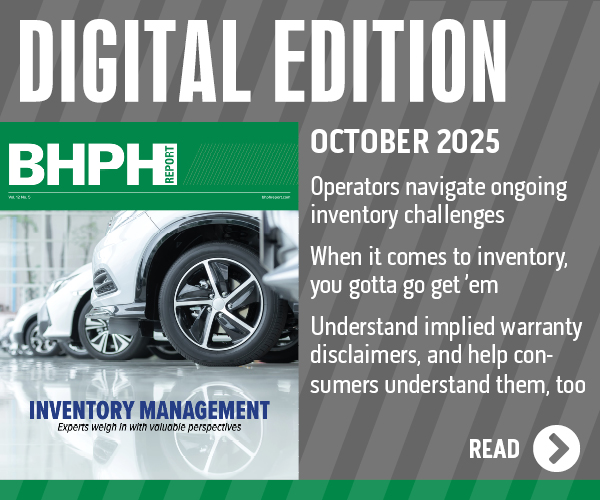COMMENTARY: Beyond the credit score & how holistic underwriting drives BHPH success

By subscribing, you agree to receive communications from Auto Remarketing and our partners in accordance with our Privacy Policy. We may share your information with select partners and sponsors who may contact you about their products and services. You may unsubscribe at any time.
Not long ago, the buy-here, pay-here industry had a reputation for selling cars to anyone with a pulse. In those days, high-volume and low-selectivity lending practices meant loan approvals were nearly automatic.
But rising inventory and account-servicing costs have made performance the new gold standard. It’s become too expensive to lend to everyone who walks in the door. Today’s BHPH dealerships must be more strategic in determining customer fit to protect both parties. The goal is to create win-win scenarios where dealerships mitigate risk while helping borrowers successfully reach the end of their loan terms.
Oak Motors is adapting to these new economic realities by moving to a more holistic view of underwriting, which attempts to understand each of our customers’ unique circumstances. We believe this updated approach augments the limitations of traditional lending practices.
The limitations of traditional underwriting
Credit scores play a role in every lending decision, but they only tell part of the story. A score is a useful metric for telling us what happened. However, it doesn’t explain why something happened or what comes next.
The vast majority of BHPH customers have subprime credit scores with significant blemishes, sometimes including previous repossessions. Yet two borrowers with the same low credit score could have very different trajectories.
We once had a customer visit one of our dealerships with a repossession on their record. As it turned out, their car was totaled in an accident, and they didn’t have gap protection to cover the difference between the car’s value and their loan balance. Up until the accident, they had an unblemished ownership history. But after the accident, they faced a significant remaining loan balance they couldn’t pay, which ultimately forced their lender to repossess the totaled car.
Subscribe to Auto Remarketing to stay informed and stay ahead.
By subscribing, you agree to receive communications from Auto Remarketing and our partners in accordance with our Privacy Policy. We may share your information with select partners and sponsors who may contact you about their products and services. You may unsubscribe at any time.
Compare that with a customer who put 60,000 miles on a car in a single year, skipped oil changes and blew the engine. Both people might have identical credit scores and repossessions on their records, but the circumstances and their implications for future performance are vastly different.
BHPH lenders need a framework that allows us to understand not just what happened, but also the patterns of behavior that might predict future outcomes. That requires looking beyond the numbers to a more comprehensive evaluation framework.
A framework for holistic assessment
Every customer who walks through our dealership doors receives the same level of professionalism, respect and service. From there, our underwriting approach combines data and a structured set of questions to assess their situation.
Looking at the past and toward the future
The assessment process involves collecting traditional financial data, such as current income, credit score, past loan history, rent or mortgage payment history and their ability to make a down payment. Next, we examine their employment history, housing situation and length of employment to get a sense of their overall stability.
Vehicle ownership history is also a critical element of our review process. We tend to question how long the customer has owned their previous vehicle or how well they maintained it. These patterns often predict future behavior more reliably than a credit score. This history also helps us understand what circumstances led them to their current situation and what, if anything, has changed.
Beyond financial data, we try to determine a potential customer’s goals, including their vehicle needs, budget and willingness to commit to ongoing maintenance, repairs and insurance coverage.
Crafting sustainable deals
This process isn’t about excluding people from our customer base. It’s about understanding circumstances well enough to structure deals that actually work. When we match them with the right vehicle on sustainable terms, both parties benefit. The customer gets the reliable transportation they can afford to maintain, and we build a performing loan that doesn’t end in repossession.
The goal is to reach the point where we can confidently tell someone: this vehicle fits your needs, this payment fits your budget and here’s how to make it work. Achieving that requires every department to work in unison.
Collaboration ensures better outcomes
No single department has the complete picture. A sales associate may understand a customer’s needs, but our service department understands vehicle condition, and our underwriting team understands risk assessment. When these teams work together, they can create deals that give customers the best chance of success going forward.
Consider a customer who has done everything required of them to maintain their vehicle, but the car wears out through regular use. In that case, the best solution might be to skip the repair and help them trade it in for something newer, even if it means we don’t make any money on the transaction. A decision like that requires input from every department to structure terms that work for the customer’s situation.
Similarly, when we learn through our assessment that a customer typically drives 50,000 miles per year, we need to be mindful of inventory selection. We wouldn’t match them with something that already has 150,000 miles on it because that car would reach the end of its useful life before they finish paying for it. That match requires coordination among team members who understand the customer’s needs, the available inventory and the financial terms.
This approach works because every team member focuses on the same outcome: helping borrowers successfully complete their loans.
The sustainable path forward
Implementing a holistic underwriting approach can’t happen overnight. Adopting a new lending philosophy requires significant investments in teams, training and technology to do it the right way. These requirements might give some BHPH operators pause. Yet this investment is essential. The economics have changed so dramatically over such a short time that the old model is no longer feasible. Performance must become the new north star in the BHPH industry, and building deals that actually work for borrowers is one of the best sustainable paths forward.
The BHPH industry serves a vital role in the American economy. In many instances, our dealerships are the last resort for customers to obtain transportation, allowing them to work and care for their families. Holistic underwriting is how we fulfill that responsibility. By building more sustainable deals today, we protect our ability to serve this critical market tomorrow.
Tiger Okeley is the executive board member of Oak Motors, a buy-here, pay-here dealership celebrating 40 years of empowering people in central Indiana.


